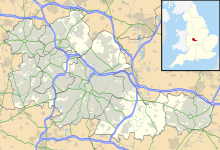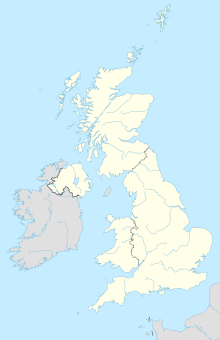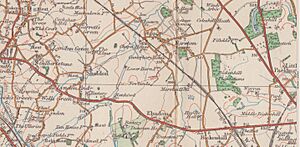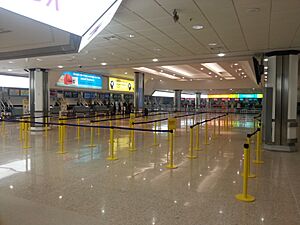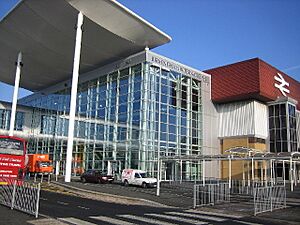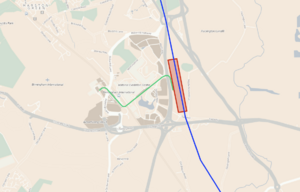Birmingham Airport facts for kids
Quick facts for kids
Birmingham Airport
|
|||||||||||
|---|---|---|---|---|---|---|---|---|---|---|---|
 |
|||||||||||
 |
|||||||||||
| Summary | |||||||||||
| Airport type | Public | ||||||||||
| Owner | Seven metropolitan boroughs of West Midlands county (49%), the Ontario Teachers' Pension Plan (48.25%) and employees (2.75%) | ||||||||||
| Operator | Birmingham Airport Ltd | ||||||||||
| Serves | West Midlands conurbation, City of Coventry, Warwickshire, Stoke on Trent, Staffordshire, Shropshire, Worcestershire, Northamptonshire, Leicestershire and Oxfordshire | ||||||||||
| Location | Bickenhill, England, UK | ||||||||||
| Elevation AMSL | 341 ft / 104 m | ||||||||||
| Coordinates | 52°27′14″N 001°44′53″W / 52.45389°N 1.74806°W | ||||||||||
| Map | |||||||||||
| Runway | |||||||||||
|
|||||||||||
| Statistics (2024) | |||||||||||
|
|||||||||||


Birmingham Airport (BHX/EGBB), once known as Birmingham International Airport, is a major airport in England. It is located about 7 miles (11 km) east-southeast of Birmingham city centre. The airport is near the village of Bickenhill in the Metropolitan Borough of Solihull.
The airport first opened on 8 July 1939 as Elmdon Airport. During World War II, the Air Ministry took over the airport. It was used by the Royal Air Force (RAF) and the Royal Navy for flight training. It also helped with wartime aircraft production. On 8 July 1946, the airport reopened for regular flights.
Birmingham Airport has a special licence from the CAA. This licence allows it to handle flights for public passengers and flying lessons. In 2017, over 12.9 million passengers used the airport. This made it the seventh busiest airport in the UK. The airport offers flights to many places in Europe, Africa, the Middle East, North America, the Caribbean, and the Indian subcontinent. It is a main base for airlines like easyJet, Jet2.com, Ryanair, and TUI Airways.
Contents
Where is Birmingham Airport?
Birmingham Airport is located about 7 miles (11 km) east-southeast of Birmingham city centre. It is in the Metropolitan Borough of Solihull. The airport is next to the National Exhibition Centre on its east side. To the north is Marston Green, and to the west is Sheldon. The villages of Bickenhill and Elmdon are to the south.
The airport is mainly reached by the A45 road. It is also close to Junction 6 of the M42 motorway. An elevated train system, the Air-Rail Link, connects the airport to Birmingham International railway station. This station is on the West Coast Main Line.
Because of its location and the direction of its main runway (15/33), planes often fly directly over Birmingham when landing or taking off. There used to be another runway (06/24), but it is now used as a taxiway for planes to get to the main runway.
Airport History
Building the Airport
In 1928, the Birmingham City Council decided the city needed its own airport. A committee was formed to make this happen. By 1931, places like Shirley and Elmdon were considered. Progress was slow due to money cuts during the Great Depression.
In 1933, the airport project started again. A new committee was set up in 1934. Before building, committee members visited successful airports in Europe. They went to cities like Amsterdam, Berlin, and London in 1935.
In January 1935, the architects Norman and Dawbarn were asked to help design the airport. The city council bought land for the airport in 1933 and 1934. In 1936, a special law was passed by Parliament. This law allowed more land to be bought and roads to be moved for the airport.
Work began on preparing the ground and designing the buildings. This included the main terminal and hangars. By January 1937, the designs were ready. In October 1937, builders were hired for the airport's buildings. The whole project cost about £360,000. Construction was fast, and the airport was ready for planes by 1 May 1939.
On 8 July 1939, the Duchess of Kent, Princess Marina of Greece and Denmark, officially opened Elmdon Airport. The Prime Minister, Neville Chamberlain, was also there. The terminal building was designed in the Art Deco style. It had the airport's air traffic control tower. This building was used as a terminal until 1984. It is still used today for staff offices and private flights. The airport was owned and run by Birmingham City Council. Early flights went to places like Croydon and Glasgow.
Second World War Use
During World War II, the Air Ministry took over Elmdon Airport. It was called RAF Elmdon. It was used as a flying school and a base for the Fleet Air Arm. During this time, the original grass landing area was replaced with two hard runways.
Many Avro Lancaster and Stirling bombers were made at the Austin Aero Company's factory. These large planes could not take off from the factory's short runways. So, their wings were removed, and they were taken by road to RAF Elmdon. After their wings were put back on, they were tested there. Once ready, they flew to their military units. On 8 July 1946, the airport reopened for civilian flights.
From 1950 to 1980
After the war, the airport hosted public events like air fairs. In 1949, regular flights started with British European Airways (BEA) flying to Paris. More flights to Europe were added over the years. These included services to Zürich, Düsseldorf, and Amsterdam between 1955 and 1960. In 1960, the City of Birmingham took over running the airport again.
In 1961, a new terminal building called The International Building opened. This helped with the increasing number of international flights. The airport's main runway was made longer between 1967 and 1970. It became 7,400 feet (1.4 miles) long. This allowed new services using turboprop and jet-powered planes. A new flight to New York started in 1967 using a Vickers VC10 plane. By the early 1970s, Birmingham Airport handled about one million passengers each year. In 1974, the West Midlands Metropolitan County Council took over managing the airport.
On 16 September 1980, the super-fast Concorde plane visited Birmingham Airport for the first time. On 20 October 2003, Concorde made its last visit to the airport as part of its farewell tour.
From 1981 to 2000
Birmingham Airport was home to the world's first commercial maglev system. This was a slow-speed maglev shuttle. It ran on a 620-metre track between the terminal and Birmingham International railway station. The Birmingham Airport Maglev opened in April 1984 after a year of testing.
However, the Maglev link stopped working in 1995 after 11 years. It was closed because it often broke down. The old track remained, and people thought about fixing it or using it for something else. In 2003, a new cable-pulled system, the Air-Rail Link Cable Liner, opened. It used the old track and much of the existing setup.
In 1993, new government rules limited how much public money airports could borrow. This meant Birmingham Airport could only grow using private money. So, 51% of the local council's shares were sold. This changed the airport into a private company. This led to a £260 million plan to improve the airport in 1997.
The 2000s
In November 2007, Birmingham Airport shared its plan for growth until 2030. This plan, called "Towards 2030: Planning a Sustainable Future for Air Transport in the Midlands," detailed changes to terminals and runways. These plans caused some debate among environmental groups and local people. Some disagreed with the need for a second runway. However, plans for a second runway and a new terminal could create many jobs. It was thought the airport could handle 70 million passengers a year if these plans went ahead.
In January 2008, the shorter runway (06/24) was closed. It was not used often because it was short and caused noise. Its position also crossed the main runway, making it costly to keep open. Closing it allowed more space for planes to park. However, runway 06/24 is still used as a taxiway and for helicopters. In the same month, plans for extending the main runway and building a new air traffic control tower were sent to Solihull Metropolitan Borough Council.
In June 2008, work started on a new three-story International Pier. It opened on 9 September 2009. To celebrate the airport's 70th birthday, the Airbus A380 was the first plane to use the new pier. This was the first commercial A380 flight in the UK outside London Heathrow Airport. The new pier is 240 metres long and 24 metres wide. Departing passengers use the top level, and arriving passengers use the middle level. The ground floor has offices for airlines. This new area has air-bridges for seven large planes. It can also fit 13 smaller planes. It can handle modern, fuel-efficient planes like the Airbus A340-600 and the Boeing 777X. The pier also has a new lounge for business class Emirates passengers. In March 2009, the runway extension plans were approved.
The 2010s
In September 2010, it was announced that the airport would change its name to "Birmingham Airport." This happened after Terminals 1 and 2 were combined into one building in 2011. A marketing company was hired to create a new look for the airport. This new look would show its current place in the market and its future plans. Figures showed that 8 million people live within an hour's drive of the airport. However, less than 40% of them used it. The name change aimed to make the airport more visible. In November 2010, the new name began to be used. The new logo, with blue circles, and the slogan, "Hello World," showed the airport's goal to be a global travel hub.
In January 2011, the viewing gallery, 'Aviation Experience And Gift Shop', closed. In the same month, the airport combined its two terminals into one building. This involved adding two new floors. A new lower ground floor holds the Arrivals and Meet & Greet area. A third floor was built in the Millennium Link and the two terminals. This floor holds the new Centralised Security Search area. In July 2011, construction of a new control tower began. The new control tower was finished in March 2012. It replaced the airport's first tower, which had been used since 1939.
On 23 February 2011, Birmingham Airport said that the High Speed 2 railway could help with London's airport capacity problems. Airport managers suggested it would be faster to get to London from Birmingham than from Stansted Airport once the railway was built. They also said the airport had space for nine million more passengers.
Plans for the runway extension and the new air traffic control tower were approved in March 2009. The goal was to finish them by the 2012 London Olympics. An Olympic ceremony was held at the airport on 23 April 2012. Olympic rings were put on the tower. They could be seen from the A45 road and the main terminal. This was to celebrate the lead-up to the London 2012 Olympic Games. The rings were removed after the Olympics ended. Work on the new runway began in autumn 2012. The extension needed the A45 Coventry Road to be moved. Instead of a tunnel, it was moved south of the runway to save money. In summer 2013, the new air traffic control tower started full operations. The old A45 road was closed, and the new one opened. In May 2014, the 400-metre runway extension officially opened. The full length was first used on 22 July 2014. This was when China Southern Airlines flew a charter flight between Birmingham and Beijing.
The Ontario Teachers' Pension Plan, a Canadian investor, increased its share in the airport to 48.25% in early 2015. It also owns all of Bristol Airport. Birmingham handled over 11.6 million passengers in 2016. This was a record for the airport. It made it the seventh busiest UK airport.
On 28 September 2016, £100 million was invested in a new baggage handling system and two new car parks. This included a drop-off car park.
Since 2020
The British airline Flybe used to fly many routes from Birmingham. These were to places in the UK and Europe. However, it stopped flying on 4 March 2020. It later started flying again, using Birmingham as its main base. In 2020, during the COVID-19 pandemic, a temporary morgue was set up in an airport hangar. It had space for 12,000 bodies.
On 13 January 2023, Emirates announced they would bring back the Airbus A380 for their daily flights to Birmingham Airport. This started on 1 July 2023. Emirates had used the A380 for Birmingham flights since 2016. But they switched to the Boeing 777 during the COVID-19 pandemic due to fewer passengers.
In January 2023, the airline Flybe, which was the successor to the earlier airline, stopped all its flights. Its main base was in Birmingham.
Airport Terminals
Birmingham Airport's current terminal building combines the two older terminals. This was done through the Millennium Link. Now, it is one large terminal. Gates 1–20 are in what was Terminal 2. All other gates are in what was Terminal 1. All check-in desks and arrivals are on the ground floor. The main security area, along with shops and restaurants, are on the first floor.
Terminal 1 opened on 3 April 1984. This was 17 years after plans to build a new terminal began. The new terminal was meant to ease crowding in the original Elmdon Terminal. The old Elmdon Terminal is now used for private and official flights. Since 1984, Terminal 1 has been made bigger many times. This was to handle more passengers and planes.
Airlines and Destinations
Passenger Flights
The following airlines fly regularly to and from Birmingham:
| Airlines | Destinations |
|---|---|
| Aer Lingus | Belfast–City, Dublin |
| Air France | Paris–Charles de Gaulle |
| Air India | Amritsar, Delhi |
| Aurigny | Guernsey |
| Brussels Airlines | Brussels |
| Corendon Airlines | Seasonal: Antalya |
| easyJet | Alicante, Amsterdam, Antalya, Barcelona, Belfast–International, Berlin, Derry (begins 1 September 2025), Edinburgh, Enfidha, Fuerteventura, Geneva, Gibraltar, Glasgow, Gran Canaria, Jersey, Lanzarote (begins 26 October 2025), Lisbon, Málaga, Malta, Marrakesh, Milan–Linate, Paris–Charles de Gaulle, Prague, Sharm El Sheikh, Tenerife–South Seasonal: Bordeaux, Corfu, Dalaman, Faro, Grenoble (begins 20 December 2025), Heraklion, Hurghada, Innsbruck, Kos, Kraków, Larnaca, Palma de Mallorca, Reykjavík–Keflavík, Rhodes, Rovaniemi |
| Emirates | Dubai–International |
| Eurowings | Düsseldorf Seasonal: Prague |
| Jet2.com | Agadir, Alicante, Antalya, Barcelona, Budapest, Faro, Fuerteventura, Funchal, Gran Canaria, Málaga, Malta, Marrakesh, Palma de Mallorca, Paphos, Prague, Rome–Fiumicino, Tenerife–South Seasonal: Almería, Athens, Bergen, Bodrum, Burgas, Catania, Chambéry, Chania, Cologne/Bonn, Corfu, Dalaman, Dubrovnik, Gdańsk, Geneva, Girona, Grenoble, Heraklion, Ibiza, Innsbruck, İzmir, Jerez de la Frontera, Kalamata, Kefalonia, Kos, Kraków, Lanzarote, Larnaca, Menorca, Mytilene, Naples, Nice, Olbia, Palermo (begins 6 May 2026), Pisa, Porto, Preveza/Lefkada, Pula, Reus, Reykjavík–Keflavík, Rhodes, Salzburg, Samos (begins 4 May 2026), Santorini, Skiathos, Split, Tallinn (begins 28 November 2025), Thessaloniki, Tivat, Turin, Venice, Verona, Vienna, Zakynthos |
| KLM | Amsterdam |
| Loganair | Aberdeen, Isle of Man |
| Lufthansa | Frankfurt, Munich |
| Pegasus Airlines | Istanbul–Sabiha Gökçen |
| Qatar Airways | Doha |
| Ryanair | Alicante, Barcelona, Beauvais, Bergamo, Berlin, Bucharest–Otopeni, Budapest, Bydgoszcz, Cork, Dublin, Faro, Fuerteventura, Gran Canaria, Knock, Kraków, Lanzarote, Lisbon, Łódź, Madrid, Málaga, Malta, Murcia, Palma de Mallorca, Paphos, Porto, Poznań, Seville, Shannon, Sofia, Tenerife–South, Treviso, Valencia, Verona Seasonal: Chania, Corfu, Girona, Grenoble, Ibiza, Perpignan, Pisa, Plovdiv, Reus, Rhodes, Rovaniemi (begins 27 October 2025), Santander, Stockholm–Arlanda, Toulouse, Turin, Zadar |
| Saudia | Jeddah |
| Scandinavian Airlines | Copenhagen |
| SunExpress | Antalya Seasonal: Dalaman, İzmir |
| Swiss International Air Lines | Zurich |
| TUI Airways | Agadir, Boa Vista, Cancún, Enfidha, Fuerteventura, Funchal, Gran Canaria, Hurghada, Lanzarote, Málaga, Marrakesh, Montego Bay, Sal, Sharm El Sheikh, Tenerife–South Seasonal: Alicante, Antalya, Barbados, Burgas, Chambéry, Chania, Corfu, Dalaman, Dubrovnik, Faro, Girona, Heraklion, Ibiza, Innsbruck, Kavala, Kefalonia, Kittilä, Kos, Kuusamo, Larnaca, La Romana, Melbourne/Orlando, Menorca, Naples Palma de Mallorca, Paphos, Pula, Punta Cana, Reus, Rhodes, Rovaniemi, Salzburg, Santorini, Skiathos, Sofia, Thessaloniki, Toulouse, Turin, Verona, Zakynthos |
| Turkish Airlines | Istanbul |
| Vueling | Barcelona |
| Wizz Air | Bucharest–Otopeni, Budapest, Craiova, Rome–Fiumicino, Sibiu (begins 28 October 2025), Suceava (begins 15 December 2025) |
Cargo Flights
| Airlines | Destinations |
|---|---|
| Hong Kong Air Cargo | Hong Kong |
| Lufthansa Cargo | Dublin, Frankfurt |
| Maersk Air Cargo | Billund |
| Silk Way West Airlines | Baku |
| Zimex Aviation | Dublin, Frankfurt |
Airport Statistics
|
|
|||||||||||||||||||||||||||||||||||||||||||||||||||||||||||||||||||||||||||||||||||||||||||||||||
Busiest Routes
| Rank | Airport | Passengers handled |
% change 2023/24 |
|---|---|---|---|
| 1 | Dublin | 810,525 | |
| 2 | Dubai–International | 608,866 | |
| 3 | Amsterdam | 590,264 | |
| 4 | Palma de Mallorca | 444,183 | |
| 5 | Tenerife–South | 437,850 | |
| 6 | Alicante | 402,893 | |
| 7 | Antalya | 361,435 | |
| 8 | Málaga | 361,379 | |
| 9 | Belfast–International | 359,839 | |
| 10 | Paris–Charles de Gaulle | 325,015 |
Getting To and From the Airport
Public Transport Options
Trains
Birmingham Airport is connected to Birmingham International railway station. This station is on the main train line between Birmingham and London. Trains are run by companies like West Midlands Trains and Avanti West Coast. A free train system called the Air-Rail Link connects the station to the airport terminal.
Future High Speed Rail
A new train station called Birmingham Interchange is planned as part of the High Speed 2 rail link. This station will serve both the airport and the National Exhibition Centre. It will be built across the M42 motorway. A "rapid transit people mover" will connect it to the airport.
Buses and Coaches
National Express West Midlands runs the main bus routes to Birmingham Airport. These include the X1 to Birmingham city centre and Coventry. The X12 goes to Chelmsley Wood and Solihull. The 96 goes to Chelmsley Wood, Erdington, and Kingstanding. Other smaller bus companies also stop at the airport. Bus stops are located outside Terminal One.
National Express Coaches also runs long-distance coaches. These coaches stop at Birmingham Airport on their way to or from Birmingham coach station.
Other Transport Options
Taxis
Black cabs are available at the taxi-rank outside the arrivals area of the terminal.
Cars
Birmingham Airport can be reached from the north and south using Junction Six of the M42 motorway. From Birmingham city centre, the A45 road goes directly to the airport. Parking costs money, even for short times. Parking spots farther from the airport are usually cheaper.
Bicycles
There is a cycle route that goes south over the A45 towards Solihull. Birmingham Airport has also shared "recommended routes" for cyclists. Free short-term bike parking is available near the terminal. For longer stays, bikes must be stored in the Left Luggage area for a fee.
See also
 In Spanish: Aeropuerto Internacional de Birmingham-West Midlands para niños
In Spanish: Aeropuerto Internacional de Birmingham-West Midlands para niños


